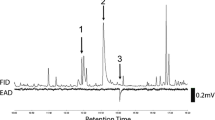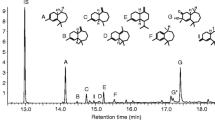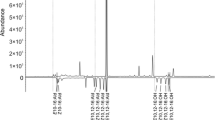Abstract
Male-produced pheromone components have been reported in the Asian longhorn beetle, Anoplophora glabripennis (Motschulsky) (Coleoptera: Cerambycidae), but field attraction to these components has been less than overwhelming. Female ALBs were observed rhythmically extending the genitalia in a manner reminiscent of female calling behaviors in other cerambycid species. We thus hypothesized that female ALBs release volatile pheromone while performing this sex-specific behavior. A group of sesquiterpenes, including a major compound α-longipinene and several minor ones α-cubebene, α-ylangene, (−)-α-copaene, α-bergamotene, β-caryophyllene, and α-farnesene, found in genitalia extracts from virgin females elicited male antennal responses. Y-tube olfactometer assays indicated significant attraction of α-longipinene to both sexes in either the presence or absence of host volatiles. This compound was also detected in genitalia extracts from virgin males, though in much lower quantities than in females. Dose–response experiments conducted in the y-tube olfactometer and field both revealed that α-longipinene was attractive at the higher doses, but not at the lower ones. In the field, traps baited with a blend containing α-longipinene, α-cubebene, and β-caryophyllene captured significantly more ALB than solvent controls. The trap catches of α-longipinene combined with either the minor components or host compounds were both greater than those of α-longipinene alone, but the difference was not significant. These results indicate that α-longipinene is a new type of female-produced volatile pheromone in ALB, and the attraction may be synergistically enhanced by several minor components. Sesquiterpenes may play an important role in intraspecies chemical communication of this insect.





Similar content being viewed by others
References
Allison JD, Borden JH, Seybold SJ (2004) A review of the chemical ecology of the Cerambycidae (Coleoptera). Chemoecology 14:123–150
Barbour JD, Cervantes DE, Lacey ES, Hanks LM (2006) Calling behavior in the primitive longhorned beetle Prionus californicus Mots. J Insect Behav 19:623–629
Cardé RT (2014) Defining attraction and aggregation pheromones: teleological versus functional perspectives. J Chem Ecol 40:519–520
Crook DJ, David RL, Mastro VC (2014) Identification of a potential third component of the male-produced pheromone of Anoplophora glabripennis and its effect on behavior. J Chem Ecol 40:1241–1250
Fanciullino AL, Gancel AL, Froelicher Y, Luro F, Ollitrault P, Brillouet JM (2005) Effects of nucleo-cytoplasmic interactions on leaf volatile compounds from citrus somatic diploid hybrids. J Agric Food Chem 53(11):4517–4523
Gao RT, Li GH (2001) A review of studies on Asian longhorned beetle Anoplophora glabripennis (Coleoptera: Cerambycidae) and development trend. Chin J Appl Entomol 38(4):252–258 (in Chinese)
Graham EE, Poland TM (2012) Efficacy of Fluon for conditioning different designs of intercept traps in capturing cerambycid beetles and the effect of Fluon on panel traps over time. J Econ Entomol 105:395–401
Haack RA, Herard F, Sun JH, Turgeon JJ (2010) Managing invasive populations of Asian longhorned beetle and citrus longhorned beetle: a worldwide perspective. Annu Rev Entomol 55:521–546
Hanks LM (1999) Influence of the larval host plant on reproductive strategies of cerambycid beetles. Annu Rev Entomol 44:483–505
Hanks LM, Millar JG (2013) Field bioassays of cerambycid pheromones reveal widespread parsimony of pheromone structures, enhancement by host plant volatiles, and antagonism by components from heterospecifics. Chemoecology 23:21–44
Hanks LM, Millar JG (2016) Sex and aggregation-sex pheromones of cerambycid beetles: basic science and practical applications. J Chem Ecol 42:631–654
Hare JD (2011) Ecological role of volatiles produced by plants in response to damage by herbivorous insects. Annu Rev Entomol 56(1):161–180
Hatano E, Kunert G, Michaud JP, Weisser WW (2008) Chemical cues mediating aphid location by natural enemies. Eur J Entomol 105(5):797–806
He P, Huang JF (1993) Adult behavior of Anoplophora glabripennis (Coleoptera: Cerambycidae). Acta Entomol Sin 36:51–55 (in Chinese)
Hoover K, Keena M, Nehme M, Wang S, Meng P, Zhang A (2014) Sex-specific trail pheromone mediates complex mate finding behavior in Anoplophora glabripennis. J Chem Ecol 40:169–180
Javal M, Roques A, Haran J, Hérard F, Keena M, Roux G (2019) Complex invasion history of the Asian long-horned beetle: fifteen years after first detection in Europe. J Pest Sci 92:173–187
Joachim C, Vosteen I, Weisser WW (2015) The aphid alarm pheromone (E)-β-farnesene does not act as a cue for predators searching on a plant. Chemoecology 25:105–113
Joo Y, Schuman MC, Goldberg JK, Sang K, Yon F, Brütting C, Baldwin IT (2017) Herbivore-induced volatile blends with both “fast” and “slow” components provide robust indirect defence in nature. Funct Ecol 32:136–149
Juliani HR, Zygadlo JA, Scrivanti R, de la Sota E, Simon JE (2004) The essential oil of Anemia tomentosa (Savigny) Sw. var. anthriscifolia (Schrad.) Mickel. Flavour Fragr J 19:541–543
Kappel AP, Trotter RT, Keena MA, Rogan J, Williams CA (2017) Map** of the Asian longhorned beetle’s time to maturity and risk to invasion at contiguous United States extent. Biol Invasions 19:1999–2013
Kovats ES (1965) Gas chromatographic characterization of organic substances in the retention index system. In: Giddings JC, Keller RA (eds) Advances in chromatography. Marcel Dekker Inc, New York, pp 229–247
Lacey ES, Moreira JA, Millar JG, Hanks LM (2008) A male-produced aggregation pheromone blend consisting of alkanediols, terpenoids, and an aromatic alcohol from the cerambycid Beetle Megacyllene caryae. J Chem Ecol 34:408–417
Lingafelter SW, Hoebeke ER (2002) Revision of Anoplophora (Coleoptera: Cerambycidae). Entomol Soc Wash, Washington
Lu Q, Zhang YF, Zhang HS (1998) Calling, mating, and ovipositing behaviors of Anoplophora glabripennis (Coleoptera: Cerambycidae). Inner Mong For Sci Technol 3:7–9 (in Chinese)
Lu Q, Zhang YF, Wang WX, Zhang HS (2000) The bioactivity of female ovipositor and gland excretion of Anoplophora glabripennis (Coleoptera: Cerambycidae). Inner Mong For Sci Technol 2:41–42 (in Chinese)
Lucero ME, Estell RE, Fredrickson EL (2003) The essential oil composition of Psorothamnus scoparius (A. Gray) Rydb. J Essent Oil Res 15(2):108–111
Lund J, Francese JA, Teale SA (2005) The effect of placement height, color and release rate on trap catches of the Asian Longhorn Beetle, Anoplophora glabripennis. In: Gottschalk KW (ed) Proceedings, XV U.S. Department of Agriculture interagency research forum on gypsy moth and other invasive species 2004; 13–16 Jan 2004; Annapolis, MD. General Technical reports NE-332. U.S. Department of Agriculture, Forest Service, Northeastern Research Station, Newtown Square
Luo YQ, Huang JF, Li JG (2000) Main achievements, problems and prospects on researches of poplar longhorn beetles in China. Chin J Appl Entomol 37(2):116–121 (in Chinese)
Meier LR, Zou Y, Millar JG, Mongold-Diers JA, Hanks LM (2016) Synergism between enantiomers creates species-specific pheromone blends and minimizes cross-attraction for two species of cerambycid beetles. J Chem Ecol 42:1181–1192
Meier LR, Millar JG, Mongold-Diers JA, Hanks LM (2019) (S)-Sulcatol is a pheromone component for two species of cerambycid beetles in the subfamily Lamiinae. J Chem Ecol. https://doi.org/10.1007/s10886-019-01071-7
Meng PS, Trotter RT, Keena MA, Baker TC, Yan S, Schwartzberg EG, Hoover K (2014) Effects of pheromone and plant volatile release rates and ratios on trap** Anoplophora glabripennis (Coleoptera: Cerambycidae) in China. Environ Entomol 43(5):1379–1388
Millar JG, Hanks LM, Moreira JA, Barbour JD, Lacey ES (2009) Pheromone chemistry of cerambycid beetles. In: Nakamuta K, Millar JG (eds) Chemical ecology of wood-boring insects. Forestry and Forest Products Research Institute, Ibaraki, pp 52–79
Morewood WD, Neiner PR, Mcneil JR, Sellmer JC, Hoover K (2003) Oviposition preference and larval performance of Anoplophora glabripennis (Coleoptera: Cerambycidae) in four eastern North American hardwood tree species. Environ Entomol 32:1028–1034
Nehme ME, Keena MA, Zhang A, Baker TC, Hoover K (2009) Attraction of Anoplophora glabripennis to male-produced pheromone and plant volatiles. Environ Entomol 38(6):1745–1755
Nehme M, Keena MA, Zhang A, Baker TC, Xu Z, Hoover K (2010) Evaluating the use of male-produced pheromone components and plant volatiles in two trap designs to monitor Anoplophora glabripennis. Environ Entomol 39(1):169–176
Ray AM, Millar JG, McElfresh JS, Swift IP, Barbour JD, Hanks LM (2009) Male-produced aggregation pheromone of the cerambycid beetle Rosalia funebris. J Chem Ecol 35:96–103
Rodstein J, Mcelfresh JS, Barbour JD, Ray AM, Hanks LM, Millar JG (2009) Identification and synthesis of a female-produced sex pheromone for the cerambycid beetle Prionus californicus. J Chem Ecol 35:590–600
Rodstein J, Millar JG, Barbour JD, McElfresh JS, Wright IM, Barbour KS, Ray AM, Hanks LM (2011) Determination of the relative and absolute configurations of the female-produced sex pheromone of the cerambycid beetle Prionus californicus. J Chem Ecol 37:114–124
SAS Institute (2011) The SAS system for Windows. Release 9.4. SAS Inst., Cary
Sawamura M, Onishi Y, Ikemoto J, Tu NTM, Phi NTL (2006) Characteristic odour components of bergamot (Citrus bergamia Risso) essential oil. Flavour Fragr J 21(4):609–615
Silva WD, Millar JG, Hanks LM (2016) 10-Methyldodecanal, an attractant pheromone produced by males of the cerambycid species Eburodachrys vittata. PLoS ONE 11(8):e0160727
Straw NA, Tibury C, Fielding NJ, Williams DT, Cull T (2015) Timing and duration of the life cycle of Asian longhorn beetle Anoplophora glabripennis (Coleoptera: Cerambycidae) in southern England. Agric For Entomol 17:400–411
Straw NA, Fielding NJ, Tibury C, Williams DT, Cull T (2016) History and development of an isolated outbreak of Asian longhorn beetle Anoplophora glabripennis (Coleoptera: Cerambycidae) in southern England. Agric For Entomol 18:280–293
Sweeney J, Silk PJ, Gutowski JM, Wu J, Lemay MA, Mayo PD, Magee DI (2010) Effect of chirality, release rate, and host volatiles on response of Tetropium fuscum (F.), Tetropium cinnamopterum Kirby, and Tetropium castaneum (L.) to the aggregation pheromone, fuscumol. J Chem Ecol 36:1309–1321
Vet LEM, Dicke M (1992) Ecology of infochemical use by natural enemies in a, tritrophic context. Annu Rev Entomol 37(1):141–172
Wickham JD, Xu Z, Teale SA (2012) Evidence for a female-produced, long range pheromone of Anoplophora glabripennis (Coleoptera: Cerambycidae). Insect Sci 19:355–371
Wiskerke JSC, Dicke M, Vet LEM (1993) Larval parasitoid uses aggregation pheromone of adult hosts in foraging behaviour: a solution to the reliability–detectability problem. Oecologia 93:145–148
Wyatt TD (2003) Pheromones and animal behaviour: communication by smell and taste. Cambridge University Press, Cambridge
Xu T, Hansen L, Teale SA (2019) Female calling behaviour in the Asian longhorn beetle (Coleoptera: Cerambycidae). Can Entomol. https://doi.org/10.4039/tce.2019.37
Yan XF, Li XJ, Luo YQ, Xu ZC, Tian GF, Zhang TL (2008) Taxis response of Anoplophora glabripennis adults to volatiles emanating from their larval host twigs. J Bei**g For Univ 30(3):80–84 (in Chinese)
Yasui H, Yasuda T, Fukaya M, Akino T, Wakamura S, Hirai Y, Kawasaki K, Ono H, Narahara M, Kousa K, Fukuda T (2007) Host plant chemicals serve intraspecific communication in the white-spotted longicorn beetle, Anoplophora malasiaca (Thomson) (Coleoptera: Cerambycidae). Appl Entomol Zool 42:255–268
Yasui H, Akino T, Fukaya M, Wakamura S, Ono H (2008) Sesquiterpene hydrocarbons: kairomones with a releaser effect in the sexual communication of the white-spotted longicorn beetle, Anoplophora malasiaca (Thomson) (Coleoptera: Cerambycidae). Chemoecology 18:233–242
Yasui H, Fujiwara-Tsujii N, Yasuda T (2019) Detection of volatile pheromone candidates from the white-spotted longicorn beetle, Anoplophora malasiaca (Coleoptera: Cerambycidae). Appl Entomol Zool 54(2):203–211
Zhang A, Oliver JE, Aldrich JR, Wang B, Mastro VC (2002) Stimulatory beetle volatiles for the Asian longhorned beetle, Anoplophora glabripennis (Motschulsky). Z Naturforsch 57:553–558
Zhang A, Oliver JE, Chauhan K, Zhao BG, **a LQ, Xu ZC (2003) Evidence for contact sex recognition pheromone of the Asian longhorned beetle, Anoplophora glabripennis (Coleoptera: Cerambycidae). Naturwissenschaften 90:410–413
Acknowledgements
We thank Ann Hajek of Cornell University for providing ALB from the Sarkaria Arthropod Research Laboratory for our use, Shaoming Hong of Huaiyuan Bureau of Forestry, Huaiyuan, Anhui, China, and Guobin Gu of Hunchun Bureau of Forestry, Hunchun, Jilin, China, for access to field sites and assistance with field work. We also thank Dr. Chunbo Zhang of Yanbian University, Yanji, Jilin, China, for providing laboratory facilities and solvents used in lure preparation. This research was made possible by the generous support of the Alphawood Foundation.
Funding
This study was funded by grants from the Alphawood Foundation to SAT.
Author information
Authors and Affiliations
Corresponding author
Ethics declarations
Conflict of interest
The authors declare that they have no conflict of interest.
Ethical approval
All applicable international, national, and/or institutional guidelines for the care and use of animals were followed.
Research involving human participants and/or animals
This article does not involve any studies with human participants or vertebrate animals.
Additional information
Communicated by J.J. Duan.
Publisher's Note
Springer Nature remains neutral with regard to jurisdictional claims in published maps and institutional affiliations.
Rights and permissions
About this article
Cite this article
Xu, T., Hansen, L., Cha, D.H. et al. Identification of a female-produced pheromone in a destructive invasive species: Asian longhorn beetle, Anoplophora glabripennis. J Pest Sci 93, 1321–1332 (2020). https://doi.org/10.1007/s10340-020-01229-3
Received:
Revised:
Accepted:
Published:
Issue Date:
DOI: https://doi.org/10.1007/s10340-020-01229-3




